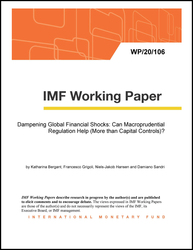
Dampening Global Financial Shocks: Can Macroprudential Regulation Help (More than Capital Controls)?
Dampening Global Financial Shocks: Can Macroprudential Regulation Help (More than Capital Controls)?
READ MORE...
Volume/Issue:
Volume 2020
Issue 106
Publication date: June 2020
ISBN: 9781513547763
$18.00
Add to Cart by clicking price of the language and format you'd like to purchase
Available Languages and Formats
| English |
Prices in red indicate formats that are not yet available but are forthcoming.
Topics covered in this book
This title contains information about the following subjects.
Click on a subject if you would like to see other titles with the same subjects.
Banks and Banking , Exports and Imports , Finance , WP , capital control , real GDP , net capital , output gap , ln VIX , trend GDP , GDP growth , monetary policy shock , policy rate , Capital controls , Central bank policy rate , Emerging and frontier financial markets , Capital outflows , Capital flows , Global , Macroprudential policies , monetary policy , net outflow , dampening effect , monetary policy response
Summary
We show that macroprudential regulation can considerably dampen the impact of global financial shocks on emerging markets. More specifically, a tighter level of regulation reduces the sensitivity of GDP growth to VIX movements and capital flow shocks. A broad set of macroprudential tools contribute to this result, including measures targeting bank capital and liquidity, foreign currency mismatches, and risky forms of credit. We also find that tighter macroprudential regulation allows monetary policy to respond more countercyclically to global financial shocks. This could be an important channel through which macroprudential regulation enhances macroeconomic stability. These findings on the benefits of macroprudential regulation are particularly notable since we do not find evidence that stricter capital controls provide similar gains.
Copyright © 2010 - 2024
Powered by:
AIDC



